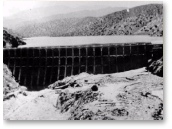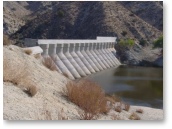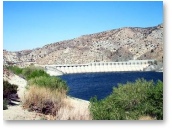 

 |
|
|
In 1886, the Palmdale Irrigation District (PID) was established to acquire land and water, and then rent, lease and sell both as they were developed. As a means of providing water for these purposes, the PID constructed a six-and-a-half mile irrigation ditch to divert water from nearby Littlerock Creek to the community of Palmdale.
 Three other water agencies, the Alpine Springs Land and Water Company, the East Palmdale Water Company, and Littlerock Creek Irrigation District, were also formed during the late 1880s and early 1890s and began appropriating water from Littlerock Creek. After a few years, the Littlerock Creek Irrigation District (LCID) acquired the facilities and assets of the former two agencies. In 1918, these local water companies, which by now had been consolidated into the Palmdale Water Company and Littlerock Creek Irrigation District, began working to finance and construct a dam on Littlerock Creek. Built primarily to supply irrigation to the Palmdale area, the Littlerock Dam was completed in 1924. With a capacity of 4,200-acre feet of water, it was considered the highest reinforced concrete multiple-arch dam in the world. This somewhat controversial design, however, caused the State of California in 1932 to declare the structure unsafe. Renovations to the dam were ordered, and by 1940 re-construction of Littlerock Dam was considered once again complete.
Three other water agencies, the Alpine Springs Land and Water Company, the East Palmdale Water Company, and Littlerock Creek Irrigation District, were also formed during the late 1880s and early 1890s and began appropriating water from Littlerock Creek. After a few years, the Littlerock Creek Irrigation District (LCID) acquired the facilities and assets of the former two agencies. In 1918, these local water companies, which by now had been consolidated into the Palmdale Water Company and Littlerock Creek Irrigation District, began working to finance and construct a dam on Littlerock Creek. Built primarily to supply irrigation to the Palmdale area, the Littlerock Dam was completed in 1924. With a capacity of 4,200-acre feet of water, it was considered the highest reinforced concrete multiple-arch dam in the world. This somewhat controversial design, however, caused the State of California in 1932 to declare the structure unsafe. Renovations to the dam were ordered, and by 1940 re-construction of Littlerock Dam was considered once again complete.
 Agricultural water use declined over the years, and with the emergence of the local aerospace industry in the 1950s, there began a shift from supplying water for agricultural purposes to supplying it for domestic use. From 1965 to 1985, the water service grew from 4,100- to 8,062-acre feet per year and doubled again in the next five years. In 1973, the parent company name was changed from Palmdale Irrigation District (PID) to Palmdale Water District (PWD) to reflect the shift from agricultural to domestic use. Today, the PWD’s boundaries include 187 square miles, with over 21,000 service connections. In addition to the Littlerock Dam reservoir, PWD receives water from local groundwater sources, as well as the State Water Project.
Agricultural water use declined over the years, and with the emergence of the local aerospace industry in the 1950s, there began a shift from supplying water for agricultural purposes to supplying it for domestic use. From 1965 to 1985, the water service grew from 4,100- to 8,062-acre feet per year and doubled again in the next five years. In 1973, the parent company name was changed from Palmdale Irrigation District (PID) to Palmdale Water District (PWD) to reflect the shift from agricultural to domestic use. Today, the PWD’s boundaries include 187 square miles, with over 21,000 service connections. In addition to the Littlerock Dam reservoir, PWD receives water from local groundwater sources, as well as the State Water Project.
To meet the increasing demand for water, in 1987 PWD constructed a water treatment plant capable of processing 12 million gallons of water per day. By 1991, the plant was processing twice as much. The need to expand the reservoir’s capacity coincided with plans to reinforce the dam against earthquakes, and therefore the huge rehabilitation project was carried out in phases. Seismic safety measures were installed and the original dam was raised 12 feet, nearly doubling the reservoir’s capacity. Once all the improvements to Littlerock Dam had been completed, dedication and re-opening ceremonies were held on June 23, 1995. The 150-acre reservoir is located on Cheseboro Road off Pearblossom Highway. It has an interpretive display center that overlooks the dam and offers fishing, boating, swimming, picnic areas, campsites, parking and restroom facilities.
 My interest in Littlerock Dam is not for its recreational activities, but rather for the small part that it has played in filmmaking. Littlerock Dam has appeared on the big screen on at least two separate occasions, namely The Far Frontier (1948) and Bells of Coronado (1950). Both productions were for Republic Pictures and starred Roy Rogers, and both were directed by the late great William Witney. I visited Littlerock Dam on October 16, 2002, and much to my surprise the gates to the dam were closed due to the dry weather conditions. Being the adventurous type, I parked the car along the side of the road and hiked roughly one mile (the heat and humidity made it seem like more) up the mountain to the dam site. After building up a sweat, I finally reached my destination; but much to my disappointment the lake level was down, probably due to drought. Nevertheless, I wasted no time capturing this site on pictures and video. I had just a glimpse of this historic locale when a park ranger drove up to the interpretive display center (overlooking the dam) and politely asked that I leave. The area was apparently closed due to extreme fire hazard conditions that stemmed from the drought. I turned to leave and trekked back down the mountain. Going down was a lot easier than climbing up, and someday I shall return to further explore this scenic movie site.
My interest in Littlerock Dam is not for its recreational activities, but rather for the small part that it has played in filmmaking. Littlerock Dam has appeared on the big screen on at least two separate occasions, namely The Far Frontier (1948) and Bells of Coronado (1950). Both productions were for Republic Pictures and starred Roy Rogers, and both were directed by the late great William Witney. I visited Littlerock Dam on October 16, 2002, and much to my surprise the gates to the dam were closed due to the dry weather conditions. Being the adventurous type, I parked the car along the side of the road and hiked roughly one mile (the heat and humidity made it seem like more) up the mountain to the dam site. After building up a sweat, I finally reached my destination; but much to my disappointment the lake level was down, probably due to drought. Nevertheless, I wasted no time capturing this site on pictures and video. I had just a glimpse of this historic locale when a park ranger drove up to the interpretive display center (overlooking the dam) and politely asked that I leave. The area was apparently closed due to extreme fire hazard conditions that stemmed from the drought. I turned to leave and trekked back down the mountain. Going down was a lot easier than climbing up, and someday I shall return to further explore this scenic movie site.
|
| |
 |
|